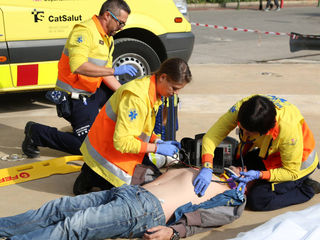Acquisition and Retention of Resuscitation Knowledge and Skills
Introduction Approximately 209 000 in-hospital adult cardiopulmonary arrests occur each year in the United States.[1] In children,...


Carbon Monoxide Toxicity Updated: Dec 26, 2017
Background Carbon monoxide (CO) is a colorless, odorless gas produced by incomplete combustion of carbonaceous material. Clinical...


ECG with a pacemaker.
This ECG is taken from an elderly man who has a history of complete heart block and AV sequential pacemaker. On the day of this ECG, he...


Bundle Branch Blocks (Part 1 – Left and Right Bundle Branch Blocks)
A bundle branch block is a disorder in which there is an obstruction in the heart’s electrical conduction system. These can be broadly...


Protocol d’atenció inicial al pacient amb lesió medul·lar aguda traumàtica
Tipus de lesions vertebrals El coll té més mobilitat espontània i, per tant, tolera una certa angulació moderada, de manera que la regió...


The Oxygenator Assessment – Part 2
In Part 1 of ‘The Oxygenator Assessment’ we learnt what the oxygentor is. In Part 2 we are going to look at the 6 big issues that need to...


Upper Limb Nerve Lesions (Part 4 – The Ulnar Nerve)
In Part 3 of our ‘Upper Limb Nerve Lesions’ series we learnt about the median nerve and the most commonly occurring lesions associated...


The Basics of ECG Interpretation (Part 2 – Rate, Rhythm and Axis)
The ECG Tracing In Part 1 of ‘The Basics of ECG Interpretation’ we learnt that the ECG is simple diagnostic test that records the...


Upper Limb Nerve Lesions (Part 3 – The Median Nerve)
In Part 2 of our ‘Upper Limb Nerve Lesions’ series we learnt about the radial nerve and the most commonly occurring lesions associated...


How Cardiopulse works
There are some different tipes of mechanical chest compression devices, the cardiopulse is one of them. Hear we can see an example of how...









































